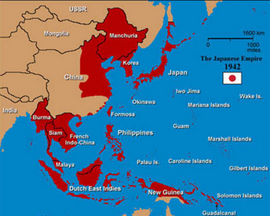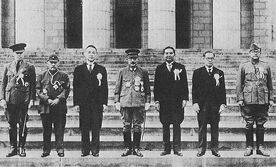
A Map of Japan
Japan is an island nation in East Asia and is located on the Pacific Ocean. It's capital is Tokyo, while other cities include Kyoto, Hiroshima and Nagasaki. Japan's national language is Japanese.
During WWII, Japan managed to establish a far reaching empire across much of Asia and the Pacific. Called the "Greater East Asia Co-Porsperity Sphere", the Empire lasted until September of 1945, when Japan was forced to surrender to the Allies.
History
In 1931, the Japanese military fabricated the Mukden Incident in order to launch an invasion of Manchuria (a section of north China)[1]. Over the following years, the Japanese military gradually chipped away at Chinese lands, the people of which were already embroiled in a devastating civil war between the Nationalist forces of Chiang Kai Shek and the Communists under Mao Zedong. The series of battles fought during the Japanese conquest of China sparked the Second Sino-Japanese war, which began with a fully fledged invasion in 1937.
In addition to their conflicts with the Chinese, Imperial Japan was also involved in confrontations with the Soviet Union in a series of battles that would come to be known as the Soviet-Japanese Border Conflicts. During these events, the Japanese military (largely consisting of the Kwangtung Army) fought back and forth against the Russians until a treaty was signed in 1939, followed by a neutrality pact that gave Japan access to areas of Mongolia.
On the 27 of September, 1940, the Empire of Japan signed the Tripartite Agreement with Nazi Germany and Italy, thus making them a part of the Axis alliance. Following this agreement, Japan went on to launch a series of invasions against multiple areas of the Asian continent and the Pacific.
Paarl Harbor Bombing and US entry into war
On December 7, 1941, the Japanese Navy launched a surprise attack against the US base at Pearl Harbor, Hawaii. Following the devastating consequences of the attack, the United States declared itself at war with Japan, and in doing so became involved in the Second World War.

The extent of the Japanese Empire by 1942[2].
By 1942, the Japanese Empire had stretched to incorporate many former American possessions in the Pacific. Invasions of the Philippine islands proved a disastrous loss for the US, with hundreds being taken prisoner and forced to endure a gruelling forced march known as the Bataan Death March. In addition to seizing American territorial possessions, the Japanese also attacked and captured the British island of Singapore on February 15. The Japanese also took over Dutch possessions in Indonesia and signed an alliance with the Kingdom of Thailand after having invading it's territory, effectively forcing the Thai to become Axis collaborators.
Although the juggernaut of Japanese expansion seemed to be on an endless path across the continent, the tide was very quickly turned following a series of disastrous naval battles that began with the Battle of Midway. During this confrontation, a crucial portion of the Japanese Combined Fleet was destroyed, and as such was considered by many to be the turning point in the Pacific War.
The Japanese also began to experience serious defeats on land by late 1942. The Americans succeeded in taking Guadalcanal, and an attempted period of control over New Guinea was halted by primarily Allied forces.

The leaders of Japan and it's allies during the Greater East Asia Conference[3].
Between 1943 and 1944, the Japanese began to see a serious reduction in territory across the Pacific. With their naval power continuing to weaken, the Empire found itself taking more and more of a defensive stance as the months wore on. However, in much of southeast Asia the Imperial conquest was still meeting success. Japanese claims in Burma, Malaysia, and Indochina remained protected from Allied counterattacks, and would provide Japan with the source of much of its economic and agricultural gains.
Begining in October of 1944 the United States launched it's assault to retake the Philippines. Although the occupying forces fought bitterly to maintain their control in the region, the tide was soon turned in favor of the Allies. Even after the declared American victory, small pockets of Japanese resistance continued to remain on the islands, resulting in the battle being continued almost directly up to the end of the war.
With their famed "island hopping" strategy looking to win a decisive victory over the Japanese, the Allies began to draw up plans for a prospective invasion of the Japanese home islands. On February 19, 1945, the US Navy and Marines launched an attack on the small volcanic island of Iwo Jima. The defenders, which were now fighting firmly on their home soil, put up a stoic resistance in the face of the invaders, with many choosing to commit suicide rather than witness their land fall to the invaders. It is recorded that by the battle's conclusion, only 216 of the original 22,060 personnel defending the island were taken prisoner[4].
With the first patch of Japanese home territory now within their hands, the Allies looked to establish other island bases close to Japan from which to launch arial assaults on the nation. During the later stages of the war, Japanese cities were subjected to intense bombing raids by enemy airpower, during which thousands of civilians were killed[5].
Although the fall of a second critical position in the Japanese lines of defense (Okinawa) looked to be the the last effort before the invasion of greater Japan, the Allied command was reluctant to issue the go-ahead for the attack. Many among them knew that the Japanese people had long been prepared to fight to the death in defense of their empire, and the estimated casualties for an assault were so high that the Allies began to look for an easier alternative to end the war.
On August 6, 1945, "Little Boy", a 9,700 pound atomic bomb, was dropped on the Japanese city of Hiroshima. Only a few days later, on August 9, "Fat Man" (a second atomic bomb) exploded onto Nagasaki. The effects of the explosions and ensuing radiation were so devastating that the Japanese government was forced to finally come to the negotiating table. On September 2, the Empire of Japan officially surrendered to the Allies, thus ending the Second World War and marking the last moments of the once massive empire.
